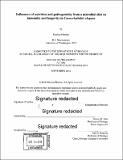Influences of nutrition and pathogenicity from a microbial diet on immunity and longevity in Caenorhabditis elegans
Author(s)
Fletcher, Marissa (Marissa Ann)
DownloadFull printable version (10.03Mb)
Other Contributors
Massachusetts Institute of Technology. Department of Biology.
Advisor
Dennis H. Kim.
Terms of use
Metadata
Show full item recordAbstract
Interactions with the environment play a critical role in animal physiology and evolution. Animals alter their cellular functions and organismal behavior to maximize survival in a given setting, or make the decision to seek out a new environment that is more compatible with life. Responses to external conditions can be carried out via sensory perception of environmental cues, or as a result to decreased cellular energy or tissue damage. Both modes of modification present complex biological questions as to how animals recognize the need to adapt, make the decision to adapt, and relay that decision into a physical outcome. This thesis focuses on how we can answer some of these questions through study of the model organism, Caenorhabditis elegans, and its interactions with its microbial environment, which serves as both a nutrient source as well as a potential pathogenic threat. In Chapter One, I provide an overview of aging and infection in C. elegans. Many of the pathways involved in regulating longevity and immunity in C. elegans are conserved in mammals, and work in this system has revealed a surprising amount of intersection of these two seemingly separate matters. Chapter Two focuses on how a TGF[beta] neuroendocrine signaling pathway contributes to lifespan extension as a result of reduced nutrient availability in adulthood, commonly known as dietary restriction. Chapter Three explores how a bZIP transcription factor works to regulate the response to pathogenic bacteria downstream of p38 MAP Kinase signaling. In Chapter Four, I present ideas for exploring the future directions of these two projects that focus on untangling how C. elegans respond to a changing microbial environment.
Description
Thesis: Ph. D., Massachusetts Institute of Technology, Department of Biology, 2018. Cataloged from PDF version of thesis. Includes bibliographical references.
Date issued
2018Department
Massachusetts Institute of Technology. Department of BiologyPublisher
Massachusetts Institute of Technology
Keywords
Biology.